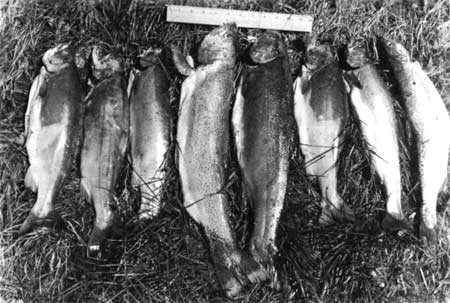|
Volume XXII - 1956
Comparative Stomach Analysis Of Crater Lake Fishes
By Dick S. Baird, Ranger-Naturalist
On account of the great interest in fishing in Crater Lake, many
studies have been, and are being, carried out to try to find out more
about the fish in Crater Lake. In any program such as this, one of the
first projects to be carried out is a stomach analysis to determine what
types of food present are being utilized by the fish.
Crater Lake, having no known inlet or outlet, could have no native
fish. All of the fish in the lake are either planted fish, or offspring
of planted fish. The first planting was carried out in 1888 by William
G. Steel. At that time he planted 37 rainbow trout fingerlings into the
lake waters. Since that time there have been many other plantings. The
first recorded plantings of the rainbow trout, (Salmo gairdnerii
gairdnerii) and the sockeye salmon, (Oncorhynchus nerka),
were carried out in 1909 by park personnel. The last plantings were in
1937 for the sockeye salmon, and 1941 for the rainbow trout.
For the last few years fishing in Crater Lake has not been
exceptional, in fact many people would refer to it as poor. The long
duration since the last stocking is undoubtedly one of the factors
affecting the condition of the fishing, but by no means the only
one.
On the basis of analyzing six rainbow trout stomachs, and four
sockeye salmon stomachs, it was found that insect forms, both adult and
larval, are the most used source of food for the fishes. Every stomach
examined contained some sort of insect material.

"Crater Lake fish. Two large rainbow trout flanked by
Sockeye salmon. N.P.S. photo."
There is a great deal of variety among the types of insects used by
the fish, as they represented nine orders or groups, and many more
families. These orders listed according to frequency of occurrence are;
the flies (Diptera), the moths and butterflies
(Lepidoptera), the beetles (Coleoptera), the bees, ants,
and wasps (Hymenoptera), the caddie flies (Trichoptera),
the mayflies (Ephemerida), the stone flies (Plecoptera)
the snake flies (Phaphidiodea) and the biting and sucking bugs
(Hemiptera).
Along with the insect forms were found the fresh water shrimp
(Hyalella), a snail, and a spider.
The breakdown as to the type of insects per species of fish is a
follows:
Rainbow Trout (six stomachs)
| Lepidoptera | five stomachs |
| Diptera | three stomachs |
| Hymenoptera | three stomachs |
| Coleoptera | three stomachs |
| Trichoptera | two stomachs |
| Phaphidiodea | one stomach |
| Hemiptera | one stomach |
Sockeye Salmon (four stomachs)
| Diptera | three stomach |
| Coleoptera | one stomach |
| Trichoptera | one stomach |
| Plecoptera | one stomach |
| Ephemerida | one stomach |
| Hymenoptera | one stomach |
It can be seen from the above that many groups of insects are used
by both types of fish fairly equally, while other orders are used more
by one type of fish than by the other. The Diptera,
Trichoptera, Coleoptera, and Hymenoptera were used
by both types of fish. The rainbow trout also made use of the
Lepidoptera, Hemiptera, and Phaphidiodea, while the
sockeye salmon made use of the Plecoptera and the
Ephemerida.
Some of these differences in food habits can be explained without
too much trouble. The abundance of the Lepidoptera in the rainbow
trout, and the lack of the same in the sockeye salmon, is due to the
fact that all of the rainbow trout were taken in 1952, which happened to
be a year of great abundance for the California tortoise-shell butterfly
in this area also. The sockeye salmon were taken in 1953 when the
California tortoise- shell butterfly was no longer in abundance,
therefore they do not occur in the sockeye salmon stomachs.
The Plecoptera and the Ephemerida in the sockeye
salmon stomachs and not in the rainbow trout stomachs might be explained
as a matter of chance. Although the individuals in the stomachs were in
abundance, all of the Plecoptera found were from the one stomach,
while all of the Ephemerida found were also taken from but one
stomach.
The presence of the Phaphidiodea and the Hemiptera in
the rainbow trout can probably be explained much the same way, merely
the chance happening across some concentrated specialized food supply,
and not a matter of different food preference between the two types of
fish.
All of the fresh water shrimp, along with the snail and the spider,
were taken from merely isolated stomachs also, which could lead one to
apply the same explanation there as used above.
As far as can be determined by this study, the food preferences in
the two types of fish in the waters of Crater Lake do not differ. Both
species of fish would probably use the same types of food if they were
available to the fish. This is born out not only by this study, but by
the angling information also, as both species of fish inhabit the same
areas, and can be taken on the same kinds of fishing lures.
| 
